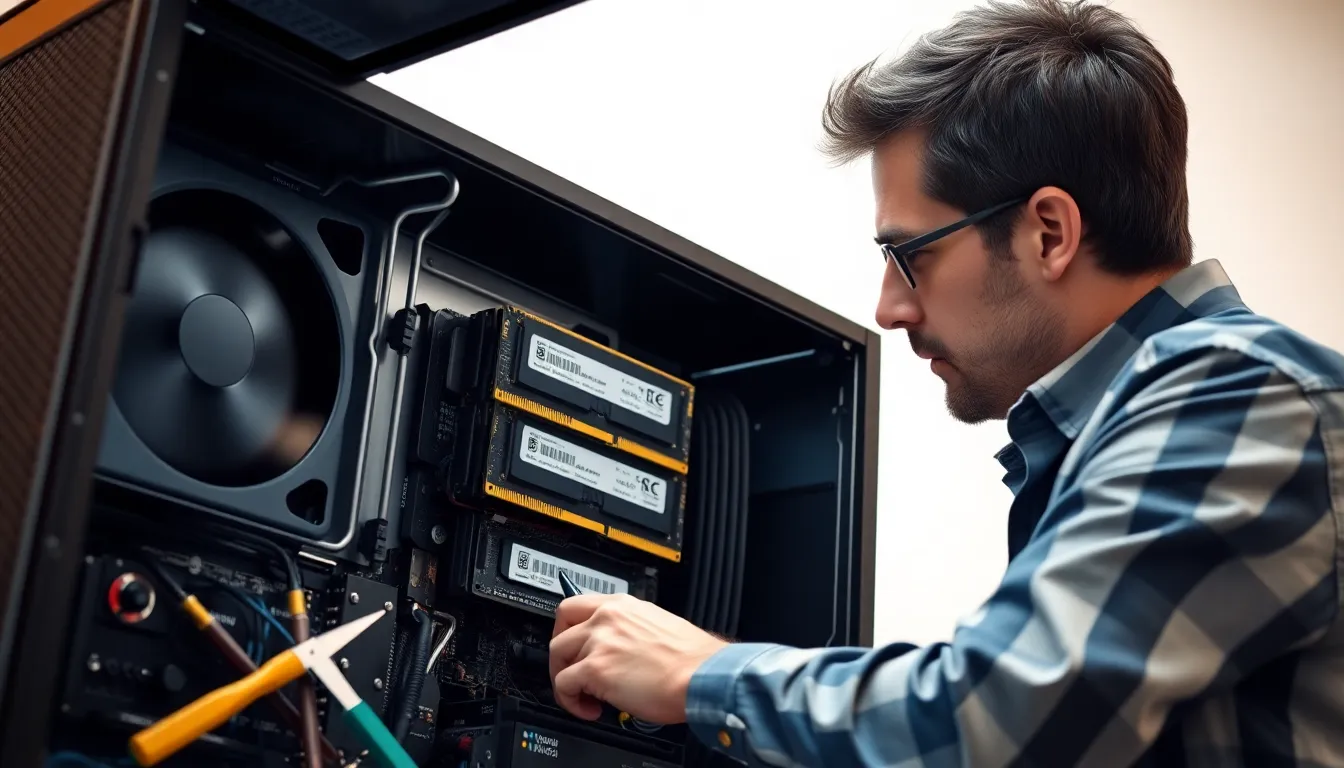Table of Contents
TogglePicture this: you’re deep into a project, coffee in hand, when suddenly your screen turns into a blue abyss of despair. The dreaded Windows Memory Management Blue Screen has struck again! It’s like your computer decided to throw a tantrum just when you thought everything was running smoothly.
Understanding Windows Memory Management Blue Screen
A Windows Memory Management Blue Screen indicates a serious system error linked to memory issues. This screen interrupts tasks and provides error codes for diagnosis.
What Is a Blue Screen Error?
A blue screen error signifies a critical system failure. Such crashes are also known as “stop errors.” Typically, they occur when Windows encounters an issue it cannot recover from without restarting. Errors relate to hardware malfunctions, driver conflicts, or corrupted files. When a blue screen error appears, it displays specific codes. These codes help users identify the underlying cause and troubleshoot effectively.
Importance of Memory Management in Windows
Memory management plays a crucial role in a stable Windows environment. Efficient management ensures applications access memory without conflicts. By allocating memory resources correctly, Windows maintains performance and system stability. Memory management involves tracking active programs, freeing unused memory, and preventing memory leaks. Proper management maximizes speed and improves user experience. Each memory-related action contributes to overall system reliability.
Causes of Windows Memory Management Blue Screen

Multiple factors contribute to the Windows Memory Management Blue Screen error. Understanding these causes aids in effective troubleshooting.
Hardware Issues
Hardware malfunctions often trigger blue screen errors. Faulty RAM ranks as a common culprit. When memory modules fail, the operating system struggles to manage tasks, leading to crashes. Overheating components can also induce memory issues. Inadequate power supply strains the hardware, resulting in unexpected failures. Maintaining clean connections and replacing defective parts reduce these risks.
Software Conflicts
Software conflicts play a significant role in blue screen occurrences. Incompatible drivers frequently cause disruptions in memory management. Outdated software might not operate well with the current system settings. Viruses or malware can corrupt essential files, triggering critical errors. Installing the latest software updates enhances compatibility, thereby preventing conflicts. Regular system scans improve overall stability and decrease the likelihood of crashes.
Troubleshooting Windows Memory Management Blue Screen
Troubleshooting the Windows Memory Management Blue Screen requires systematic approaches to resolve the underlying issues effectively. Following specific steps can clarify the situation and help regain stability.
Basic Steps to Resolve the Issue
First, restarting the computer often alleviates temporary glitches. Second, checking connections for RAM and other hardware ensures secure placements. Third, running the Windows Memory Diagnostic tool identifies potential memory issues. Fourth, users should uninstall recently added software that may conflict with system operations. Fifth, ensuring Windows is updated can also resolve compatibility problems. Lastly, users might consider performing a system restore to revert settings to a point before issues began.
Advanced Troubleshooting Techniques
If basic steps do not resolve the blue screen error, advanced techniques may be necessary. First, running the Command Prompt as an administrator and executing the sfc /scannow command checks for corrupted system files. Second, users can analyze minidump files created during crashes using debugging tools to pinpoint specific causes. Third, testing each RAM stick individually in different slots helps isolate faulty hardware. Fourth, enabling Safe Mode allows users to boot the system with minimal drivers and troubleshoot further. Lastly, removing overclock settings or under-volting components may resolve stability issues.
Preventing Windows Memory Management Blue Screen
Preventing the Windows Memory Management Blue Screen involves proactive strategies. These steps help maintain system stability and ensure smooth operation.
Regular Maintenance Tips
Establish a regular maintenance schedule to keep the computer in optimal condition. Clean dust from hardware components to prevent overheating. Check RAM for errors periodically using built-in tools. Ensure that all drivers stay updated in order to reduce conflicts. Defragment the hard drive periodically, if using HDD storage, to improve access times. Remind users to verify that software is compatible with the operating system. Regular reboots can enhance performance by refreshing system resources.
Recommended Tools and Software
Utilize specific software tools designed for system health. Windows Memory Diagnostic checks RAM for errors effectively. Reliability Monitor provides detailed insights into system issues. Driver Booster updates drivers automatically and reduces conflicts. Malwarebytes scans for malware, protecting crucial files from corruption. CCleaner cleans temporary files, optimizing system performance. Regular use of these tools safeguards against potential blue screen occurrences.
Dealing with the Windows Memory Management Blue Screen can be a daunting experience for any user. Understanding the causes and implementing effective troubleshooting methods can significantly reduce the chances of encountering this frustrating issue. Proactive maintenance and regular system checks are essential for ensuring a stable computing environment. By staying updated on software and hardware health users can enhance their system’s performance and longevity. Utilizing the right tools for diagnostics and optimization further empowers users to take control of their systems. With these strategies in place users can navigate their computing tasks with confidence and minimize disruptions.




